 Life Sciences
Life Sciences
Plant Galls and Evolution: A Neglected Study

Professor Mel T. Cook at Rutgers University1, author of The Insect Galls of Indiana2, complained in 1911 (p. 386) that “it is very doubtful if any phase of biology has been neglected more than that very conspicuous and extremely puzzling branch known as cecidology,”3 the study of plant galls. Today, almost 110 years later, Marion O. Harris (University of North Dakota) and Andrea Pitzschke (University of Salzburg) rightly deplore (2020, p. 1854) that “galls have not received the attention they deserve. They are often seen as quaint oddities rather than as indicators of interesting happenings in the world of plants and their biotic interactions.”4
To help address this neglect, I have offered a series on “Plant Galls and Evolution.” Part Three, “A Historical Sketch,” is now available to be downloaded. You will find Part One here and Part Two here.
This situation represents an astounding paradox in botanical research, and to a certain extent perhaps in modern science itself. Consider the fact that plant galls constitute an unusually widespread, in fact, globally ubiquitous and distinctly visible, multiform, and often brightly colored phenomenon, which anyone can come across and investigate to a certain extent even with little or no scientific equipment.
Light at the End of the Tunnel
I will repeat here some numbers on the occurrence of plant galls (cf. Lönnig 2020). For insect gallers alone, i.e. gall-inducing bacteria, fungi, and viruses, with nematodes and mites not included: “Estimates of the global richness of gall-inducing insects ranged from 21,000 to 211,000 species, with an average of 132,930 species.” Moreover, between 13 percent and 45 percent of the total number of about 422,000 seed plant species are involved. (See Espirito-Santo and Fernandes 2007, pp. 95-96.) Although 98 percent of these are flowering plants, galls also occur on ferns and lycopods. Santos et al. (2019, p. 53) found them in 20 fern families and one lycophyte family (altogether 93 host species belonging to 41 genera).

the larva is shown. This and the above photo by W.-E. L. (18 November 2020).
Molecular and other studies over the last few years appear to have cast some light at the end of the tunnel of neglected plant gall research. My own two extensive review papers, referred to above, are Lönnig 2017: “Plant Galls and Evolution (I): How More than Twelve Thousand Ugly Facts Are Slaying a Beautiful Hypothesis: Darwinism”5 (63 pp.), and Lönnig 2020: “Plant Galls and Evolution (II): Natural Selection, DNA, and Intelligent Design, Or: The Proof that Complex Structures of Thousands of Species Have Been Formed for the Exclusive Good of Other Species Thus Annihilating6 Darwin’s Theory”7 (55 pp.). I have included, apart from the morphology and anatomy of some galls, an overview of the most recent papers on molecular plant gall research. I would like to refer the reader interested in the details to these two reports.
The Historical Side
In my new contribution, I restrict myself to important facets of the historical side of plant gall research. My emphasis is on the origin and evolution of these phenomena from the point of view of several of the “Fathers” — as they approvingly have been called by their adherents and successors8 — of their respective scientific branches. These include Hippocrates of Kos (460-370 BC), the “Father of Modern Medicine” (Yapijakis 2009, p. 507)9; Theophrastus of Eresos (371-286 BC), often called the “Father of Botany”; Marcello Malpighi (1628-1694 AD), “known affectionately as the ‘Father of Cecidology’” (James A. Wearn 2011, p. 481)10; Carolus Linnaeus (1707-1778 AD), the “Father of Modern Taxonomy”; and especially Charles Darwin (1809-1882), often called (not quite correctly) the “Father of Evolution,”11 the “Father of the Theory of Evolution,”12 or (perhaps more accurately) the “Father of the Theory of Natural Selection.”13 My study includes, too, some present-day neo-Darwinian authors and their critics.
Lest the reader expect a full coverage of the topic, that would necessitate a book of its own. I emphasize that this is just a historical sketch and an introductory article to the topic. As is common in historical papers, the reader will find some original quotations, mostly from the primary literature.
For more, kindly see “Plant Galls and Evolution (III): A Historical Sketch.”
Notes
- https://science.sciencemag.org/content/53/1359/39.
- https://www.amazon.de/Insect-Galls-Indiana-PP-801-871/dp/B0178BFP30.
- https://www.jstor.org/stable/2467079?seq=1#metadata_info_tab_contents.
- https://nph.onlinelibrary.wiley.com/doi/epdf/10.1111/nph.16340.
- http://www.weloennig.de/PlantGalls.pdf.
- Darwin’s choice of words.
- http://www.weloennig.de/PlantGalls.xyz.pdf.
- However, in a much more comprehensive perspective — as far as positive and true results of research and actions are involved — cf. James 1:17 (πᾶσα δόσις ἀγαθὴ καὶ πᾶν δώρημα τέλειον ἄνωθέν ἐστιν, καταβαῖνον ἀπὸ τοῦ πατρὸς τῶν φώτων) (https://www.jw.org/en/library/bible/kingdom-interlinear-greek-translation/books/james/1/ and https://biblehub.com/interlinear/james/1-17.htm).
- https://pubmed.ncbi.nlm.nih.gov/19567383/.
- https://onlinelibrary.wiley.com/doi/pdf/10.1111/j.1095-8339.2011.01173.x.
- Google please: “Darwin the father of evolution”: Some 183,000 results (13 November 2020).
- Google please: “Darwin the father of the theory evolution”: 35,100 results (13 November 2020).
- Google also: “Darwin the father of the theory of natural selection”: 25,300 results (same date as above). Cunningham & Cunningham (1990:563): Environmental Science: A Global Concern (McGraw-Hill) is also often cited for this term. However, natural selection was known before Darwin.
